Rahul Mishra, Manish Malhotra, Anita Dongre dial 'click' for couture
Leaders of the luxury fashion industry are turning to digital ecommerce and virtual shows to sell designer wear in ways that have never been attempted before


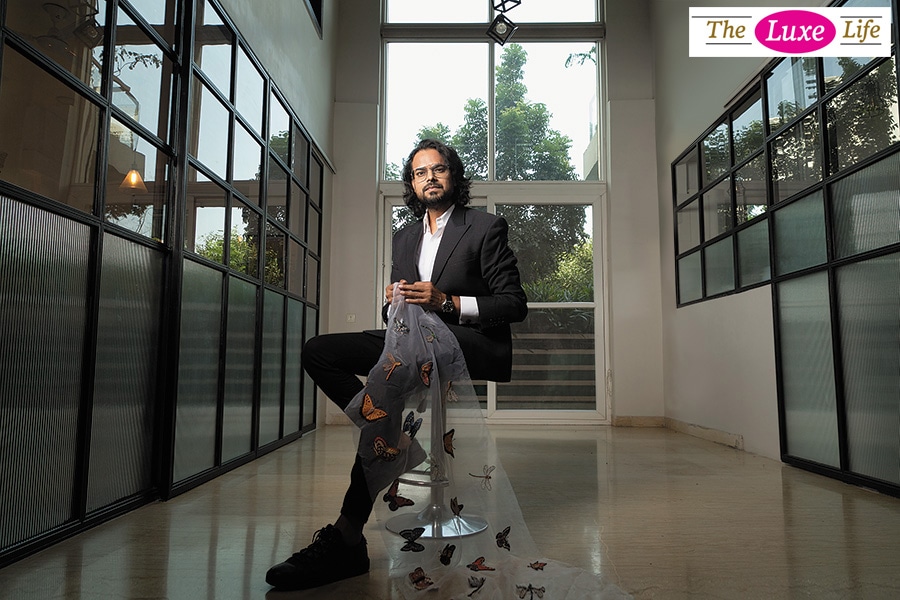 Designer Rahul Mishra says a digital presence for his label was in the works for two years and the pandemic gave him the time to think about what it would take to dive into ecommerce
Designer Rahul Mishra says a digital presence for his label was in the works for two years and the pandemic gave him the time to think about what it would take to dive into ecommerce
Image: MADHU KAPPARATH WARDROBE BY TROY COSTA
Just like the radiant brides from our favourite rom-com movies, Natasha Gaur wanted all eyes to be on her during her wedding in Mumbai. Preparations started four months in advance, and finding the right trousseau was a crucial part of the plan. The Covid-19 outbreak, however, put the brakes on the London resident’s intentions of combing through boutiques in India on an elaborate wedding shopping spree. Instead, Gaur (name changed) found herself having four-hour-long Zoom video calls with Rahul Mishra, the couturier she had chosen to design her outfit for the big day, tentatively scheduled in early December.
While she missed trying out outfits at the boutique, the 30-year-old was excited about taking the process online, which she found to be unique. Mishra had an idea about what exactly Gaur wanted, so the online appointments were focussed, productive and well-coordinated. “Rahul and his team made me feel so comfortable over the Zoom call. It was interesting, because we weren’t relying on anything visually in front of us in the store, and had to use our creativity and dive into the archives to make something special,” she recalls.
The leaders of India’s high-powered luxury fashion world, like many entrepreneurs across industries, have also turned to the digital ecosystem for a revenue-generation plan that would help them adapt to the changing realities of doing business during a pandemic. Covid-19 has been a leveller in the sense that it has also resulted in shows—the exclusive, by-invite, high-profile events of the fashion calendar—going completely online. Labels of some of the country’s most-admired designers are now sporting an e-store avatar, even as boutiques re-open.
So, as par for the course, Delhi-based Mishra has been conducting his client meetings virtually. “I constantly felt disconnected from the time when I could be in the store, with the team, and have a physical proximity with garments. But I’ve had several thrilling virtual experiences with clients that continue to remind me of why I love what I do,” says Mishra, who launched his online store in July. The 40-year-old designer says that a digital presence was in the works for two years and the pandemic just turned out to be the definitive push that allowed him the time and headspace to think about what it will take to dive into ecommerce.
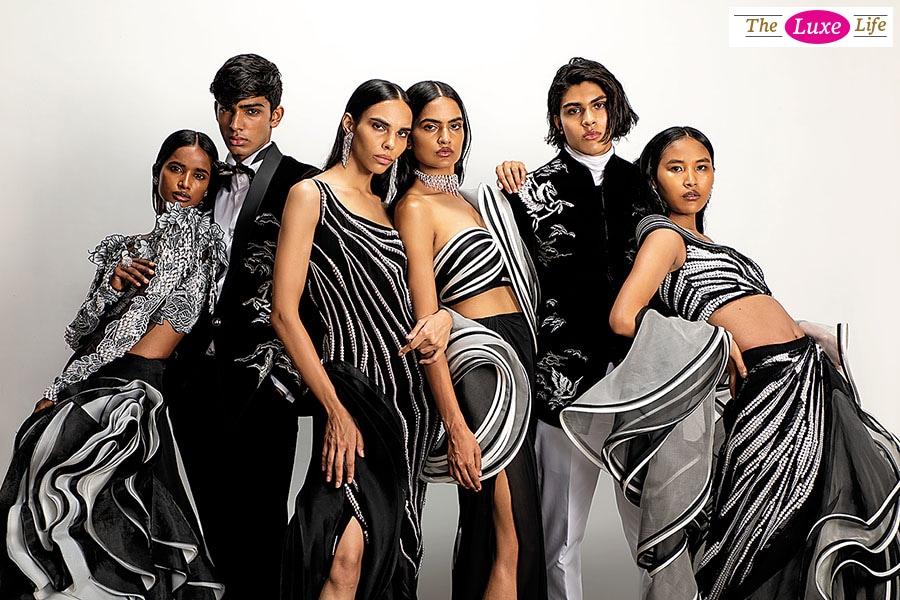 Designer Gaurav Gupta’s latest collection was unveiled at the Digital India Couture Week in September
Designer Gaurav Gupta’s latest collection was unveiled at the Digital India Couture Week in September
Courtesy: Gaurav Gupta
“The response, since day one, has been positive. The website was launched alongside our Couture Fall 2020 collection, ‘Butterfly People’, which was showcased at the Paris Haute Couture online that was also streamed live on our website. The global reach has been vast and we’ve been able to cater to a wide international market, alongside our existing clientele,” says Mishra, who has two flagship boutiques in India.
For luxury fashion labels like Mishra’s, the experience of an online platform comes with its own set of complexities. Couture is custom-made keeping in mind the smallest details and preferences of the client, most of whom still prefer human interaction to online checkouts. “While we observe signiï¬cant traffic on the website, many of those queries still get directed to WhatsApp or the flagship stores. Just vaguely quantifying, over 50 percent queries are contributed by our online platform but only 20 percent of total sales actually materialise on the portal,” adds Mishra.
According to a 2019 report by Deloitte India and the Retail Association of India, ecommerce retail in the country will touch $84 billion in 2021, up from $24 billion in 2017. But most Indian designers and boutiques hadn’t built strong online strategies until the pandemic. Designer Gaurav Gupta, known for his sculptural designs, launched his website only in September. It’s only been a month, but the Delhi-based designer is satisfied with the response received from across the globe.
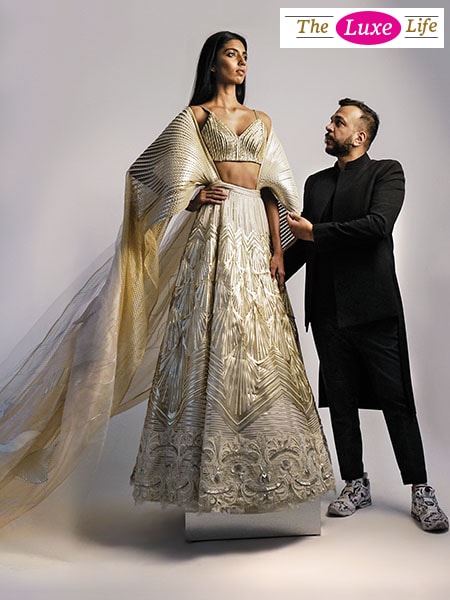 Designer Amit Aggarwal, who launched his digital store in September, says it is exciting to weave a digital narrative around his creations
Designer Amit Aggarwal, who launched his digital store in September, says it is exciting to weave a digital narrative around his creations
Courtesy: Amit Aggarwal
While many people might think twice before investing in couture online, a lot of Gupta’s clients were hesitant to visit the physical boutique due to Covid-related restrictions, and found it easier to browse through the collection online. Apart from intricate shots of garments and detailed descriptions, Gupta says that there is “a WhatsApp feature on our site for a real-time conversation with the clientele. Users can chat with our in-house fashion stylists for suggestions or customisation requests.” Apart from his own ecommerce platform, Gupta’s collections are also available on other sites like Pernia’s Pop-Up Shop, Aashni and Co, Elahe, Aza Fashions and Karma. He opened for the Fashion Design Council of India’s (FDCI) first-ever digital edition of India Couture Week 2020 in September with his fashion film, Name Is Love.
This digital shift seems to be paying off for Gupta. “We have seen a 20 percent jump in the overall sales [compared to only in-store sales], have delivered over 50 couture orders within the first month and have processed over 100-120 orders till now,” claims the designer.
Like Gupta, Delhi-based designer Amit Aggarwal is also a new entrant in fashion ecommerce who launched his digital store on September 18. Aggarwal has also attempted to offer a quintessential store experience through virtual walkthroughs and e-consultations. While the charm of a traditional runway show is undeniable, the ability to weave a digital narrative around his creations and their craftsmanship is exciting for Aggarwal. “Technology has been about liberation, and we have to evolve and adapt. We believe in pushing boundaries, innovating channels of communication and interaction with our customers,” he says.
In a similar attempt at evolution through innovation, couturier siblings Shantanu and Nikhil Mehra had decided to launch their luxury ready-to-wear brand ‘S&N by Shantanu and Nikhil’ in April. With the onset of the pandemic, the duo decided to turn to ecommerce along with two offline stores. “Today, we have a platform with SAP-integrated data to bring consumers closer to the brand and its overall experience as an omnichannel network,” says Shantanu.
The luxury ready-to-wear brand was born of a strategic joint venture with retail giant Aditya Birla Fashion & Retail Ltd (ABFRL) in 2019. The designer duo hopes to integrate more tech elements like artificial intelligence to “make the consumer experience more nuanced” going forward. Though their ecommerce platform is still fledgling, the designers claim that 10 percent of their total monthly revenue comes from online sales.
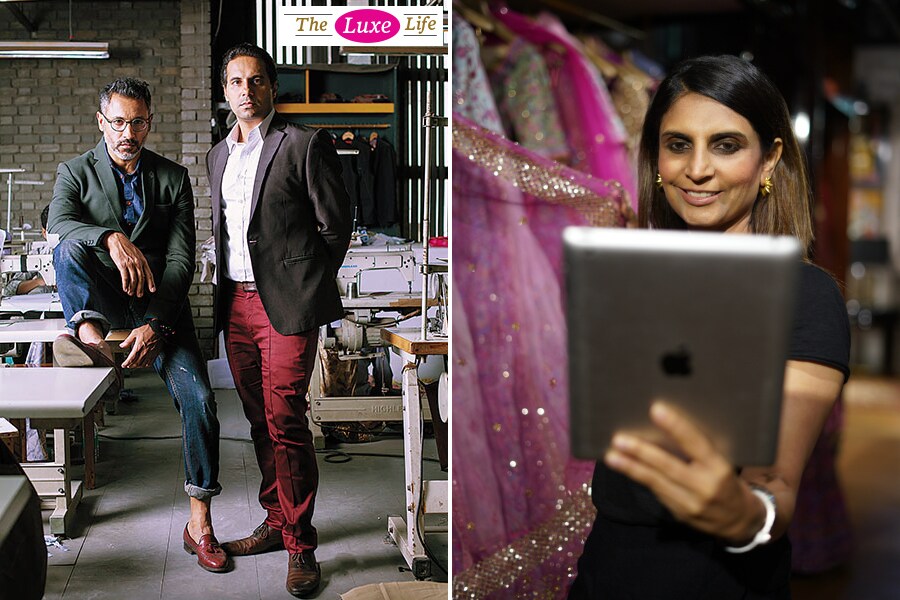 (Left) For designers Nikhil (left) and Shantanu Mehra, 10 percent of their monthly revenue comes from online (Right) Monica Shah of JADE by Monica and Karishma. The duo also conduct live Q&A sessions
(Left) For designers Nikhil (left) and Shantanu Mehra, 10 percent of their monthly revenue comes from online (Right) Monica Shah of JADE by Monica and Karishma. The duo also conduct live Q&A sessions
Courtesy: Shantanu & Nikhil Jade by Monica & Karishma
In order to make the most of their digital presence, high-end fashion designers are now aggressively using social media as a marketing tool. “I personally like to sit down with my press team to ensure that our grids are curated with extreme precision and variety, so our online audience can consume our content across different mediums,” Gupta says.
Another label, JADE by Monica and Karishma, has launched an Instagram series, JADE Closet, featuring videos of how couture from their latest festive collection can be styled to achieve a variety of looks. To drive online engagement, the designers have been posting tutorials for brides via videos and conduct live Q&A sessions. They have also launched an online concierge service where the designers “handhold customers through the in-store walkthrough process and address their queries and concerns instantly, as if they were at the store”, says Monica Shah, creative director and co-founder, JADE by Monica and Karishma.
Apart from individual designers, joining the digital bandwagon are luxury retailers, such as Ensemble India, helmed by Tina Tahiliani Parikh. The store, which stocks collections of 50 to 75 designers, moved online in March 2020.
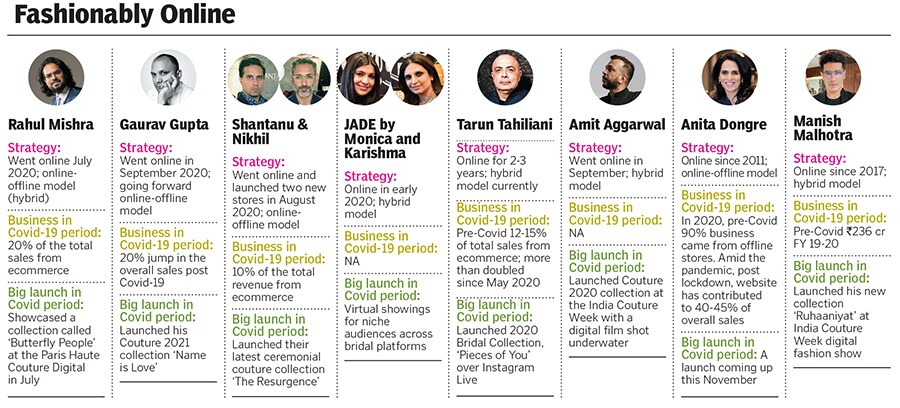
Early on due to the pandemic, one of the biggest challenges Parikh and her team faced was logistical issues in delivering outfits to customers. The store has two models on its website: Ready-to-ship and made-to-order. With the latter, she says, “it was taking a little longer for each piece to be made, because labour was unavailable and factories were shut [during the lockdown].” Parikh, who also offers consultations via the store website, says that given the gradual growth in digital orders, the website will “remain a central part of content strategy going forward”.
Learn from the Best
The digital route for luxury brands in India will require a lot of planning, and technologies like artificial intelligence, augmented reality/virtual reality and data analytics will require a lot of investment, explains Sheetal Jain, CEO and founder of Luxe Analytics, a luxury market research and advisory firm. “For a successful digital expedition, tools like 360 degree viewing and virtual dressing rooms are must-haves. The human element needs to entwine skilfully with digital tools to make consumers feel well-attended to during their purchases.”
While the new entrants are still experimenting, the designers who were early movers in the ecommerce space have been using this time to build on their digital presence. “During the first lockdown, we revamped the user-interface of our website and made it more convenient for shopping experience,” says fashion designer Manish Malhotra, who marks 30 years in the industry this year and had launched his website—which offers a range of couture, light couture and smart couture pieces—almost three years ago.
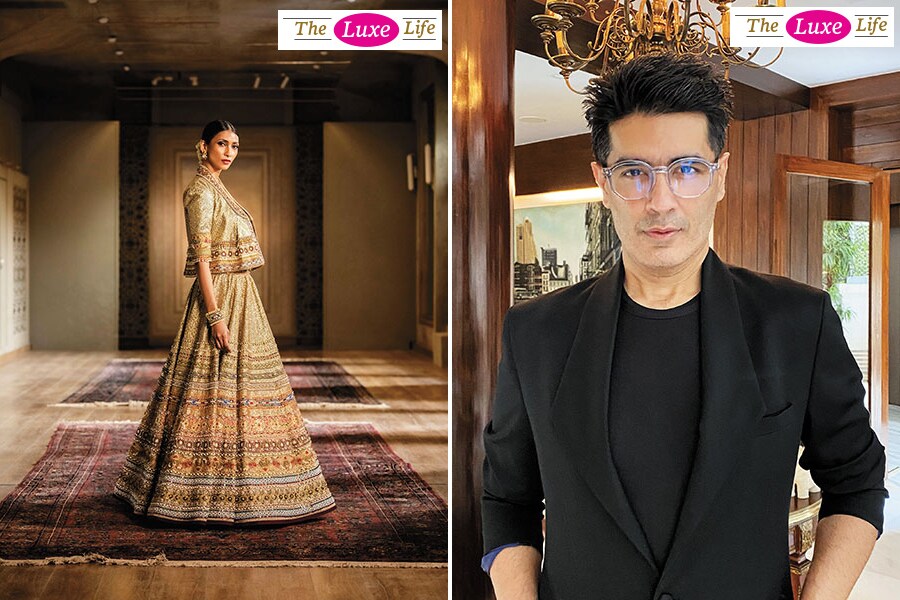 (Left) Designer Tarun Tahiliani’s latest womenswear collection titled ‘Pieces of you’ was launched virtually on July 15 (Right) Designer Manish Malhotra says they are exploring virtual reality and other technologies to further upgrade their online experience
(Left) Designer Tarun Tahiliani’s latest womenswear collection titled ‘Pieces of you’ was launched virtually on July 15 (Right) Designer Manish Malhotra says they are exploring virtual reality and other technologies to further upgrade their online experience
Courtesy: Tarun Tahilini and Manish Malhotra
Malhotra explains that the digital dependency of the fashion industry has increased, because of which he has a dedicated team for keeping his digital presence up-to-date, and ensuring consumers are offered a seamless experience from login to checkout. “We’re exploring virtual reality (VR) and other technologies to upgrade our online retail experience further,” he adds, saying that the online sales are below one percent of his total revenue but growing at a “satisfying” pace. His pre-Covid revenue for FY19-20 stood at Rs 236 crore.
Another veteran designer, Tarun Tahiliani, who is celebrating his 25th year in the industry, says that 12 to 15 percent of his total sales came from ecommerce earlier, but “the number has more than doubled since May 2020”. In July, Tahiliani launched his bridal collection, ‘Pieces of You’, over Instagram Live, which was ‘attended’ by more than 8,000 people. Since then, the video of the show has been viewed more than 33,000 times.
“We realised early on during the pandemic that there has to be synergy between online and offline. People are researching online, reaching out to us and requesting to connect them to our stores, facilitating the final conversion from Zoom call, videos, chats etc,” he says. While he is wary that a digital fatigue might soon creep in among customers, in order to keep in with the times, he has been trying to facilitate virtual dressing rooms and a smooth ecommerce experience.
“I am interested to see what happens when brick-and-mortar retail gets back on its feet in the new normal,” says Anita Dongre, for whom online contribution to total sales has grown from 10 percent pre-Covid to 45 percent since the lockdown. “This year has unlocked the true potential of the internet as a source of retail business,” says the designer, who had launched her digital store back in 2011.
The chief creative officer of House of Anita Dongre has now started taking virtual appointments, where stylists take customers through the collection in a virtual walkthrough of each her two flagship stores in Delhi and Mumbai. Shopping for luxury requires more conversation and a high standard of customer care, explains Dongre. “Our stylists are available seven days a week, exactly like in a store. The website experience, however, is at the heart of it. So the upside is that customers are not limited by that single store’s inventory.”
The ‘Phygital’ Model
Another integral aspect of the fashion industry—live shows—are also becoming virtual. During the pandemic, designers showcased their collection either as part of the fashion week live broadcast or through their own social media channels. “Designers had the freedom to break through different rules and regulations to do things their way,” says Sunil Sethi, chairman, FDCI. Democratisation of fashion through the digital medium was such that instead of 500 people watching the show in a closed space, the FDCI received up two lakh views for each of their 12 shows, Sethi says. “Some designers told me of instances where a customer from Rohtak, Haryana, drove down to Delhi the very next day to pick up something he had seen in the virtual showcase.”
As the industry inches back to normalcy, the FDCI wants to explore a ‘phygital model’ for shows. Its next event—Lotus Make-up India Fashion Week—from October 14, has a physical studio for designers to shoot their fashion films and videos. The pre-recorded videos will then be streamed across FDCI’s digital channels. An online showroom is being created where designers can upload their lookbooks and reserve orders from their buyers through virtual meetings.
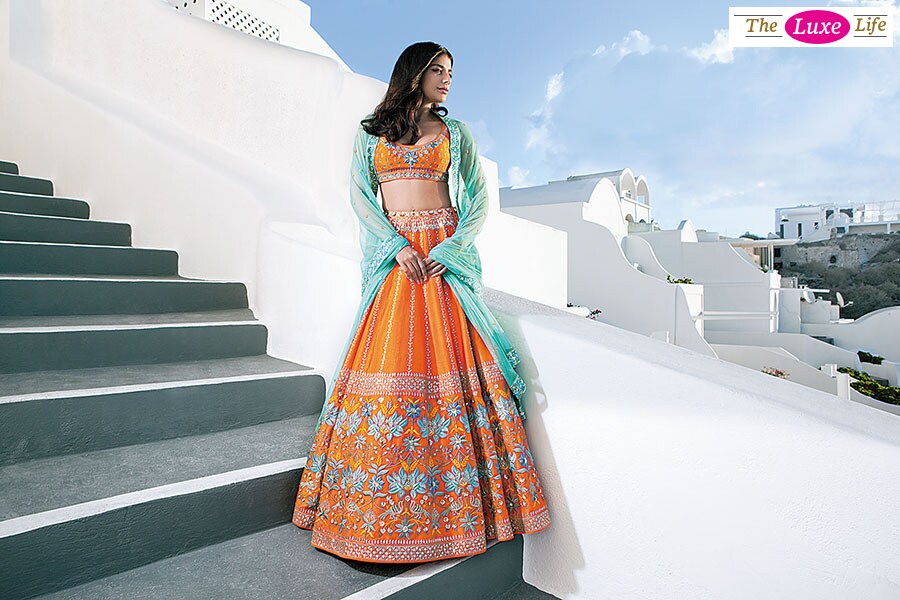 Designer Anita Dongre’s Summer 2020 collection tilted ‘Summer in Santorini’ was launched in stores and online in March 2020. The designer had launched an online store in 2011 and says the online contribution to their total sales has grown from 10 percent from pre-covid to 45 percent since the lockdown
Designer Anita Dongre’s Summer 2020 collection tilted ‘Summer in Santorini’ was launched in stores and online in March 2020. The designer had launched an online store in 2011 and says the online contribution to their total sales has grown from 10 percent from pre-covid to 45 percent since the lockdown
Courtesy: Anita Dongre
The Lakme Fashion Week (LFW) is also experimenting with a hybrid model this year. The event will be live from October 21 to 25 on a virtual platform, which will also have an online showroom where buyers can connect with designer labels to make purchases. “The intent is to create a template that will seamlessly fit into the overall event even when we return to a physical version in the future,” says Jaspreet Chandok, head of lifestyle businesses at IMG Reliance that organises the event.
The Indian luxury market was on an upward trajectory until last year, with a Euromonitor International forecast suggesting that the emerging luxury sector in the country will see a compound annual growth rate of 18.1 percent from 2019 to 2023. With Covid-19, as the global fashion industry stares at a loss of $600 billion loss in sales this year as per media reports, designers in India are also bound to face the heat.
Most couturiers consider a digital-only presence as just a temporary fix, and believe that long-term survival demands hybrid channels. Gupta has already adopted this model. Most of his clients select couture from their homes. They then visit the stores to make the final purchase “after getting a final look, feel and fit of the garment”, the designer says. According to him, this makes the shopping experience more efficient.
Jain of Luxe Analytics agrees. “The hybrid model is the way forward,” she says. “Designers cannot rely only on physical stores, particularly for this new age [of discerning young luxury consumers].”
First Published: Oct 19, 2020, 15:19
Subscribe Now